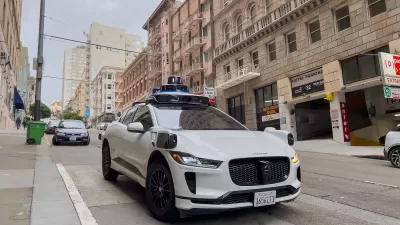In cities across the United States, robotaxis, championed by companies like Waymo and Cruise, are a marvel of modern technology and a flashpoint for debate over their place in urban transit.

“Robotaxis appeared with promises of safety, accessibility, and environmental benefits. The appeal is clear: driverless taxis eliminate the need for human drivers, theoretically reducing human error in accidents and lowering transportation costs for the public.” But as an article in Cities of the Future explains and Planetizen has chronicled, their impact on the rest of the transportation system and urban infrastructure becomes more evident.
Waymo, for example, touts its extensive safety protocols, with each vehicle equipped with a suite of sensors, including lidar, radar, and cameras that can operate with higher precision than human vision. Early data seems to indicate that, in controlled environments, robotaxis have lower accident rates than human-driven cars, but high-profile crashes involving autonomous cars have created an atmosphere of mistrust.
“The rollout could have been smoother. Cities like San Francisco have already seen issues with these vehicles interacting poorly with emergency services and blocking public transit lanes, causing frustration among officials and residents. Incidents in which AVs halt suddenly in traffic or interfere with emergency responders highlight concerns about their readiness for the unpredictable nature of urban driving. In response, some residents have attempted to disable AVs by placing traffic cones on their hoods, expressing a belief that these vehicles may worsen, rather than improve, traffic congestion and public safety.”
FULL STORY: Robotaxis Wreak Havoc on Urban Transit

Planetizen Federal Action Tracker
A weekly monitor of how Trump’s orders and actions are impacting planners and planning in America.

Maui's Vacation Rental Debate Turns Ugly
Verbal attacks, misinformation campaigns and fistfights plague a high-stakes debate to convert thousands of vacation rentals into long-term housing.

Restaurant Patios Were a Pandemic Win — Why Were They so Hard to Keep?
Social distancing requirements and changes in travel patterns prompted cities to pilot new uses for street and sidewalk space. Then it got complicated.

In California Battle of Housing vs. Environment, Housing Just Won
A new state law significantly limits the power of CEQA, an environmental review law that served as a powerful tool for blocking new development.

Boulder Eliminates Parking Minimums Citywide
Officials estimate the cost of building a single underground parking space at up to $100,000.

Orange County, Florida Adopts Largest US “Sprawl Repair” Code
The ‘Orange Code’ seeks to rectify decades of sprawl-inducing, car-oriented development.
Urban Design for Planners 1: Software Tools
This six-course series explores essential urban design concepts using open source software and equips planners with the tools they need to participate fully in the urban design process.
Planning for Universal Design
Learn the tools for implementing Universal Design in planning regulations.
Heyer Gruel & Associates PA
JM Goldson LLC
Custer County Colorado
City of Camden Redevelopment Agency
City of Astoria
Transportation Research & Education Center (TREC) at Portland State University
Jefferson Parish Government
Camden Redevelopment Agency
City of Claremont





























